Knowledge Management Assignment: Enhancing Employee Personal Worth
VerifiedAdded on 2022/11/01
|14
|2430
|297
Homework Assignment
AI Summary
This assignment delves into the realm of knowledge management, specifically focusing on strategies to enhance employee motivation and personal worth. The solution addresses various methods, including praise, showcasing exemplary employees, and gamification, as effective means to boost morale and productivity without relying solely on financial incentives. The assignment further explores decision-making processes, advocating for the active involvement of employees in critical decisions affecting their welfare. It details a step-by-step approach to group discussions, including silent idea generation, round-robin recording, serial discussion, and voting, culminating in a consensus-based decision-making process. The assignment also presents an analysis of different frames, such as horse, student, and airline, using an instance frame to describe specific examples. Finally, it analyzes a case study to uncover the failures of knowledge management in an organization, highlighting issues related to technology, content, and project management, and emphasizes the importance of communication and analytical skills in constructing knowledge-based systems.
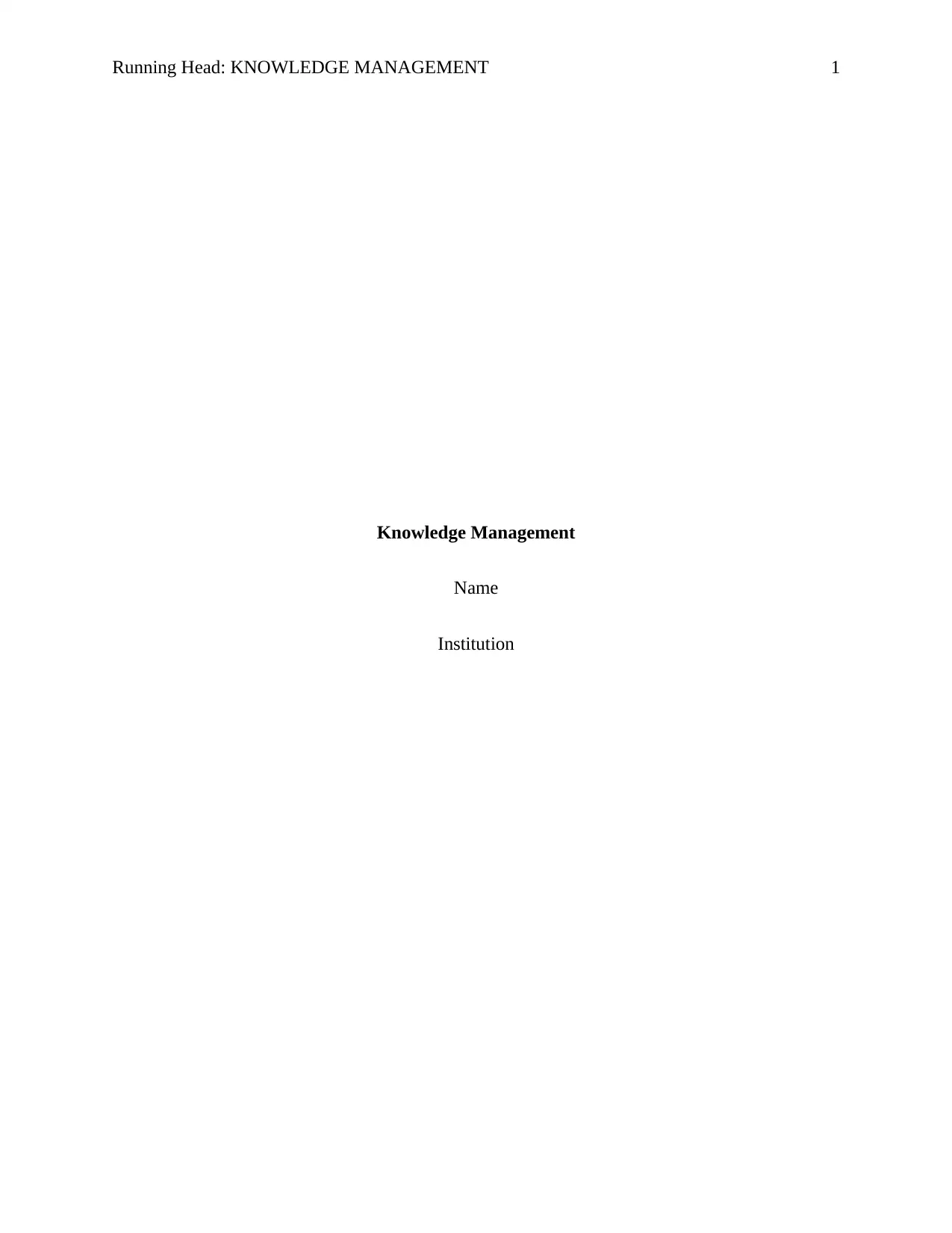
Running Head: KNOWLEDGE MANAGEMENT 1
Knowledge Management
Name
Institution
Knowledge Management
Name
Institution
Paraphrase This Document
Need a fresh take? Get an instant paraphrase of this document with our AI Paraphraser
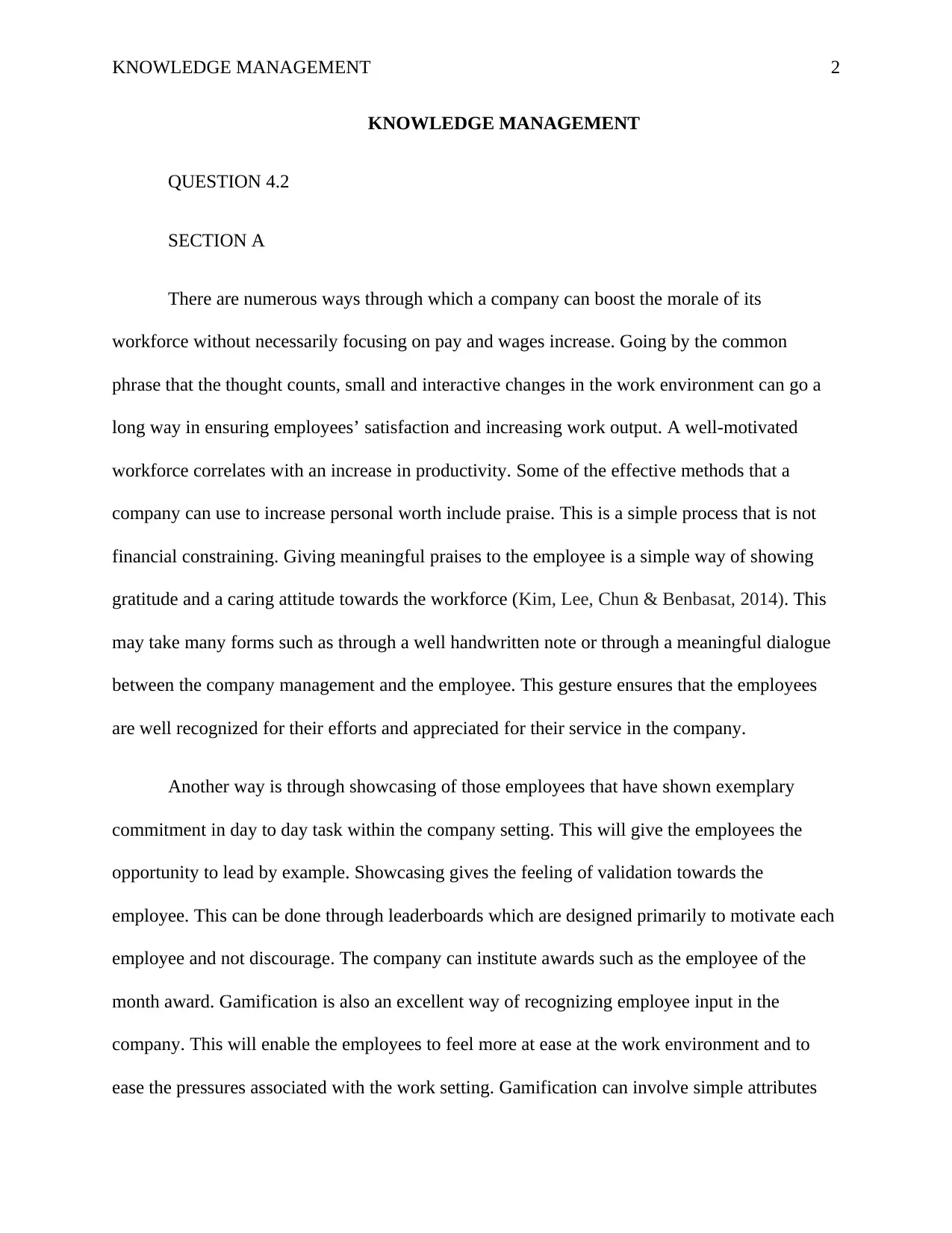
KNOWLEDGE MANAGEMENT 2
KNOWLEDGE MANAGEMENT
QUESTION 4.2
SECTION A
There are numerous ways through which a company can boost the morale of its
workforce without necessarily focusing on pay and wages increase. Going by the common
phrase that the thought counts, small and interactive changes in the work environment can go a
long way in ensuring employees’ satisfaction and increasing work output. A well-motivated
workforce correlates with an increase in productivity. Some of the effective methods that a
company can use to increase personal worth include praise. This is a simple process that is not
financial constraining. Giving meaningful praises to the employee is a simple way of showing
gratitude and a caring attitude towards the workforce (Kim, Lee, Chun & Benbasat, 2014). This
may take many forms such as through a well handwritten note or through a meaningful dialogue
between the company management and the employee. This gesture ensures that the employees
are well recognized for their efforts and appreciated for their service in the company.
Another way is through showcasing of those employees that have shown exemplary
commitment in day to day task within the company setting. This will give the employees the
opportunity to lead by example. Showcasing gives the feeling of validation towards the
employee. This can be done through leaderboards which are designed primarily to motivate each
employee and not discourage. The company can institute awards such as the employee of the
month award. Gamification is also an excellent way of recognizing employee input in the
company. This will enable the employees to feel more at ease at the work environment and to
ease the pressures associated with the work setting. Gamification can involve simple attributes
KNOWLEDGE MANAGEMENT
QUESTION 4.2
SECTION A
There are numerous ways through which a company can boost the morale of its
workforce without necessarily focusing on pay and wages increase. Going by the common
phrase that the thought counts, small and interactive changes in the work environment can go a
long way in ensuring employees’ satisfaction and increasing work output. A well-motivated
workforce correlates with an increase in productivity. Some of the effective methods that a
company can use to increase personal worth include praise. This is a simple process that is not
financial constraining. Giving meaningful praises to the employee is a simple way of showing
gratitude and a caring attitude towards the workforce (Kim, Lee, Chun & Benbasat, 2014). This
may take many forms such as through a well handwritten note or through a meaningful dialogue
between the company management and the employee. This gesture ensures that the employees
are well recognized for their efforts and appreciated for their service in the company.
Another way is through showcasing of those employees that have shown exemplary
commitment in day to day task within the company setting. This will give the employees the
opportunity to lead by example. Showcasing gives the feeling of validation towards the
employee. This can be done through leaderboards which are designed primarily to motivate each
employee and not discourage. The company can institute awards such as the employee of the
month award. Gamification is also an excellent way of recognizing employee input in the
company. This will enable the employees to feel more at ease at the work environment and to
ease the pressures associated with the work setting. Gamification can involve simple attributes
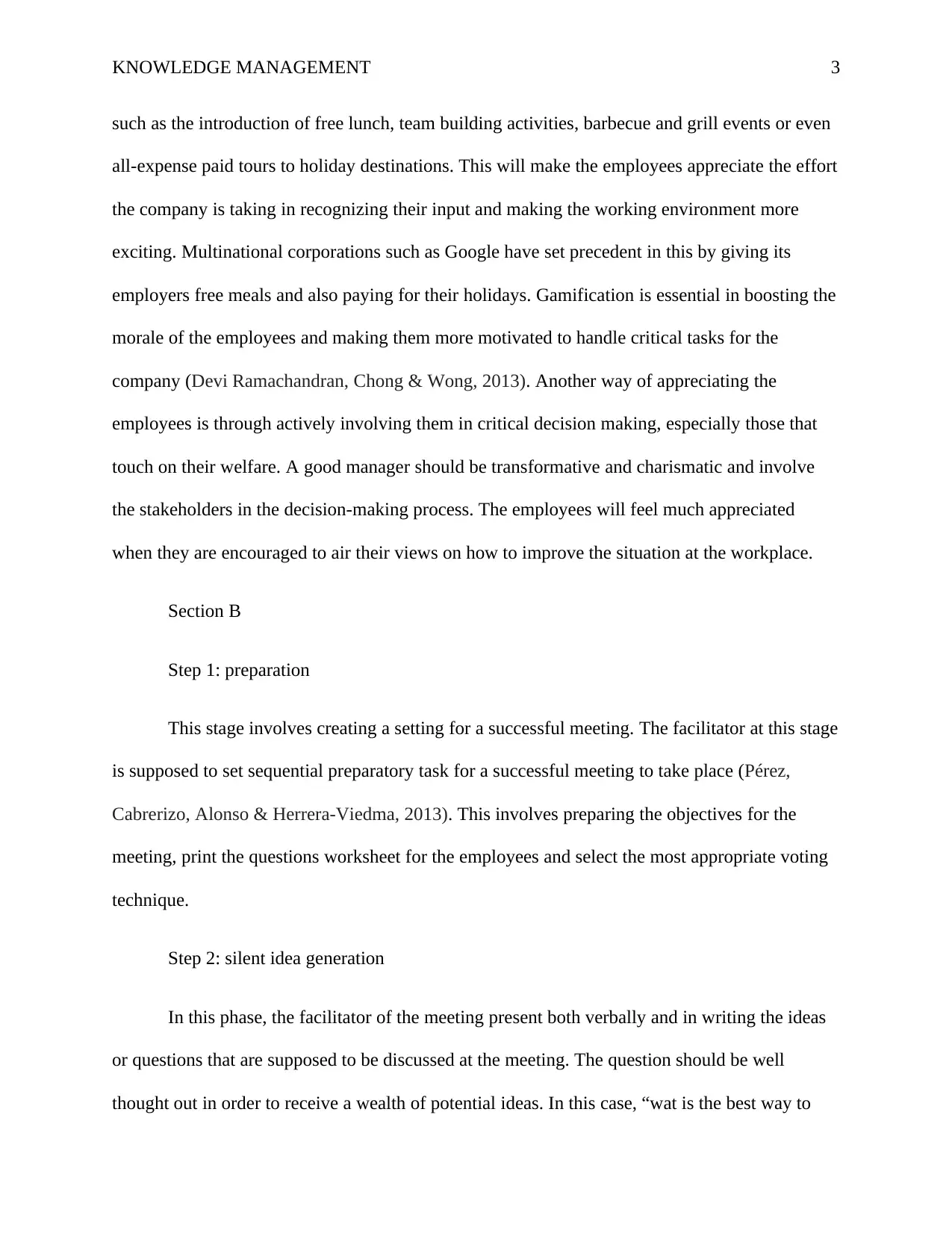
KNOWLEDGE MANAGEMENT 3
such as the introduction of free lunch, team building activities, barbecue and grill events or even
all-expense paid tours to holiday destinations. This will make the employees appreciate the effort
the company is taking in recognizing their input and making the working environment more
exciting. Multinational corporations such as Google have set precedent in this by giving its
employers free meals and also paying for their holidays. Gamification is essential in boosting the
morale of the employees and making them more motivated to handle critical tasks for the
company (Devi Ramachandran, Chong & Wong, 2013). Another way of appreciating the
employees is through actively involving them in critical decision making, especially those that
touch on their welfare. A good manager should be transformative and charismatic and involve
the stakeholders in the decision-making process. The employees will feel much appreciated
when they are encouraged to air their views on how to improve the situation at the workplace.
Section B
Step 1: preparation
This stage involves creating a setting for a successful meeting. The facilitator at this stage
is supposed to set sequential preparatory task for a successful meeting to take place (Pérez,
Cabrerizo, Alonso & Herrera-Viedma, 2013). This involves preparing the objectives for the
meeting, print the questions worksheet for the employees and select the most appropriate voting
technique.
Step 2: silent idea generation
In this phase, the facilitator of the meeting present both verbally and in writing the ideas
or questions that are supposed to be discussed at the meeting. The question should be well
thought out in order to receive a wealth of potential ideas. In this case, “wat is the best way to
such as the introduction of free lunch, team building activities, barbecue and grill events or even
all-expense paid tours to holiday destinations. This will make the employees appreciate the effort
the company is taking in recognizing their input and making the working environment more
exciting. Multinational corporations such as Google have set precedent in this by giving its
employers free meals and also paying for their holidays. Gamification is essential in boosting the
morale of the employees and making them more motivated to handle critical tasks for the
company (Devi Ramachandran, Chong & Wong, 2013). Another way of appreciating the
employees is through actively involving them in critical decision making, especially those that
touch on their welfare. A good manager should be transformative and charismatic and involve
the stakeholders in the decision-making process. The employees will feel much appreciated
when they are encouraged to air their views on how to improve the situation at the workplace.
Section B
Step 1: preparation
This stage involves creating a setting for a successful meeting. The facilitator at this stage
is supposed to set sequential preparatory task for a successful meeting to take place (Pérez,
Cabrerizo, Alonso & Herrera-Viedma, 2013). This involves preparing the objectives for the
meeting, print the questions worksheet for the employees and select the most appropriate voting
technique.
Step 2: silent idea generation
In this phase, the facilitator of the meeting present both verbally and in writing the ideas
or questions that are supposed to be discussed at the meeting. The question should be well
thought out in order to receive a wealth of potential ideas. In this case, “wat is the best way to
⊘ This is a preview!⊘
Do you want full access?
Subscribe today to unlock all pages.

Trusted by 1+ million students worldwide
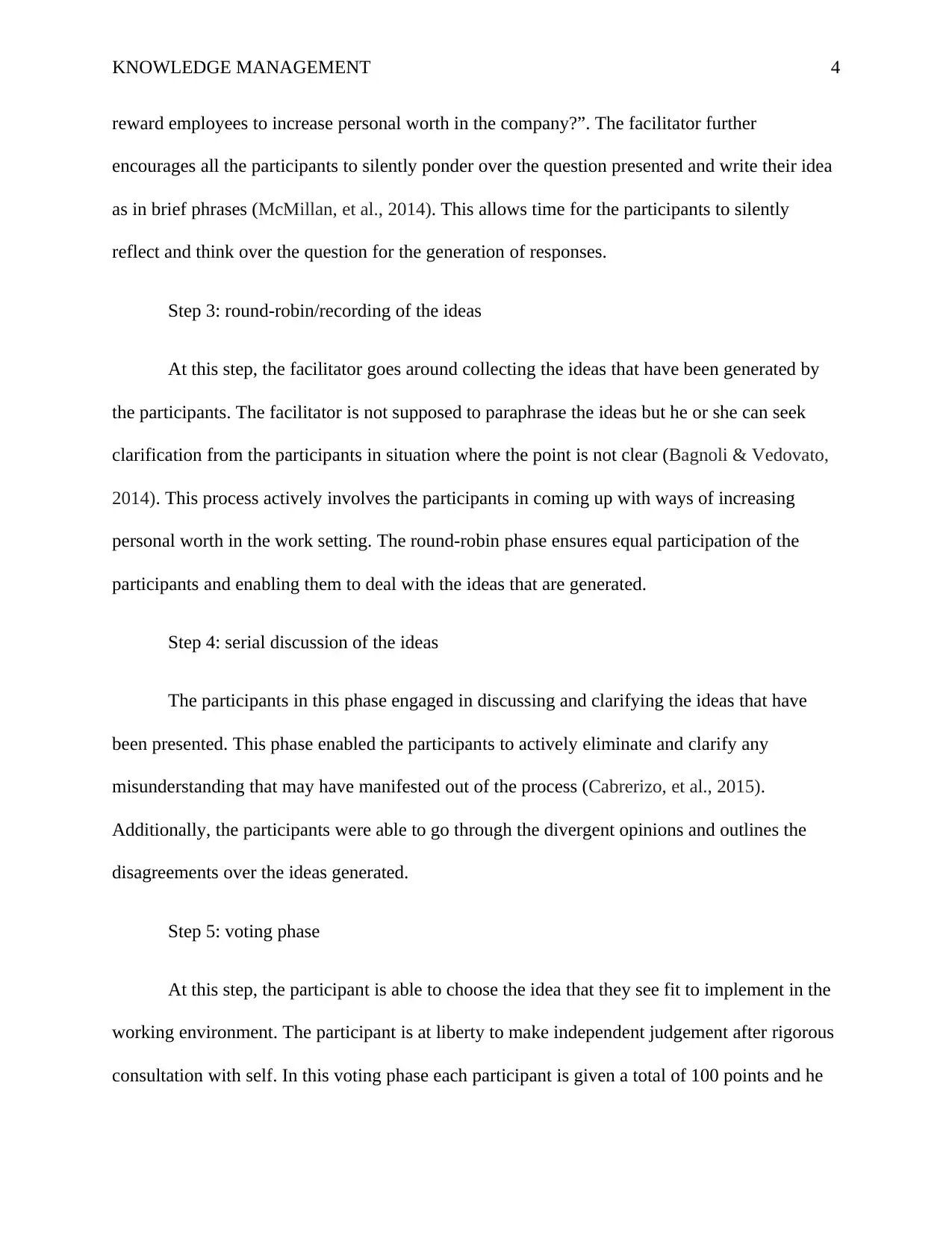
KNOWLEDGE MANAGEMENT 4
reward employees to increase personal worth in the company?”. The facilitator further
encourages all the participants to silently ponder over the question presented and write their idea
as in brief phrases (McMillan, et al., 2014). This allows time for the participants to silently
reflect and think over the question for the generation of responses.
Step 3: round-robin/recording of the ideas
At this step, the facilitator goes around collecting the ideas that have been generated by
the participants. The facilitator is not supposed to paraphrase the ideas but he or she can seek
clarification from the participants in situation where the point is not clear (Bagnoli & Vedovato,
2014). This process actively involves the participants in coming up with ways of increasing
personal worth in the work setting. The round-robin phase ensures equal participation of the
participants and enabling them to deal with the ideas that are generated.
Step 4: serial discussion of the ideas
The participants in this phase engaged in discussing and clarifying the ideas that have
been presented. This phase enabled the participants to actively eliminate and clarify any
misunderstanding that may have manifested out of the process (Cabrerizo, et al., 2015).
Additionally, the participants were able to go through the divergent opinions and outlines the
disagreements over the ideas generated.
Step 5: voting phase
At this step, the participant is able to choose the idea that they see fit to implement in the
working environment. The participant is at liberty to make independent judgement after rigorous
consultation with self. In this voting phase each participant is given a total of 100 points and he
reward employees to increase personal worth in the company?”. The facilitator further
encourages all the participants to silently ponder over the question presented and write their idea
as in brief phrases (McMillan, et al., 2014). This allows time for the participants to silently
reflect and think over the question for the generation of responses.
Step 3: round-robin/recording of the ideas
At this step, the facilitator goes around collecting the ideas that have been generated by
the participants. The facilitator is not supposed to paraphrase the ideas but he or she can seek
clarification from the participants in situation where the point is not clear (Bagnoli & Vedovato,
2014). This process actively involves the participants in coming up with ways of increasing
personal worth in the work setting. The round-robin phase ensures equal participation of the
participants and enabling them to deal with the ideas that are generated.
Step 4: serial discussion of the ideas
The participants in this phase engaged in discussing and clarifying the ideas that have
been presented. This phase enabled the participants to actively eliminate and clarify any
misunderstanding that may have manifested out of the process (Cabrerizo, et al., 2015).
Additionally, the participants were able to go through the divergent opinions and outlines the
disagreements over the ideas generated.
Step 5: voting phase
At this step, the participant is able to choose the idea that they see fit to implement in the
working environment. The participant is at liberty to make independent judgement after rigorous
consultation with self. In this voting phase each participant is given a total of 100 points and he
Paraphrase This Document
Need a fresh take? Get an instant paraphrase of this document with our AI Paraphraser
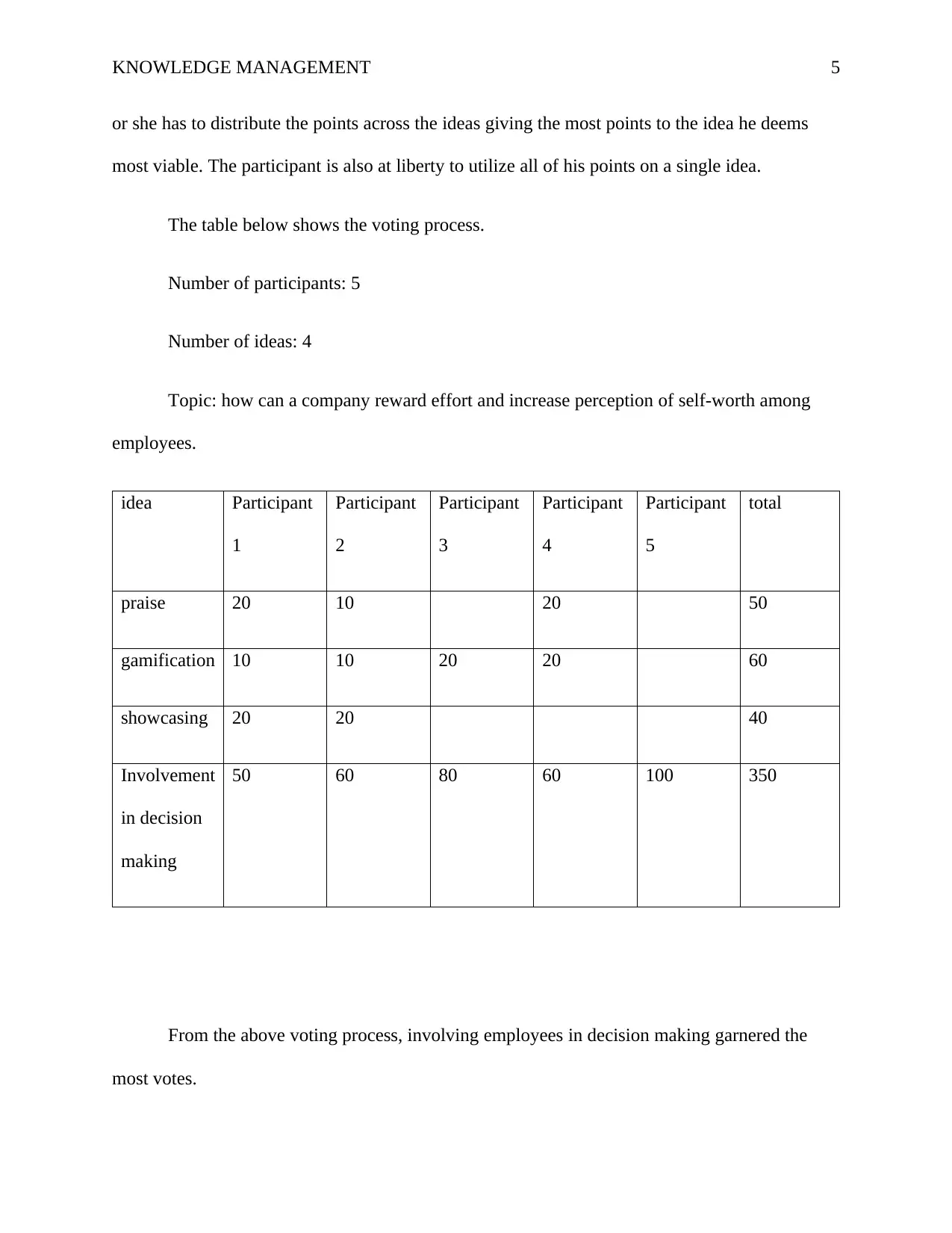
KNOWLEDGE MANAGEMENT 5
or she has to distribute the points across the ideas giving the most points to the idea he deems
most viable. The participant is also at liberty to utilize all of his points on a single idea.
The table below shows the voting process.
Number of participants: 5
Number of ideas: 4
Topic: how can a company reward effort and increase perception of self-worth among
employees.
idea Participant
1
Participant
2
Participant
3
Participant
4
Participant
5
total
praise 20 10 20 50
gamification 10 10 20 20 60
showcasing 20 20 40
Involvement
in decision
making
50 60 80 60 100 350
From the above voting process, involving employees in decision making garnered the
most votes.
or she has to distribute the points across the ideas giving the most points to the idea he deems
most viable. The participant is also at liberty to utilize all of his points on a single idea.
The table below shows the voting process.
Number of participants: 5
Number of ideas: 4
Topic: how can a company reward effort and increase perception of self-worth among
employees.
idea Participant
1
Participant
2
Participant
3
Participant
4
Participant
5
total
praise 20 10 20 50
gamification 10 10 20 20 60
showcasing 20 20 40
Involvement
in decision
making
50 60 80 60 100 350
From the above voting process, involving employees in decision making garnered the
most votes.
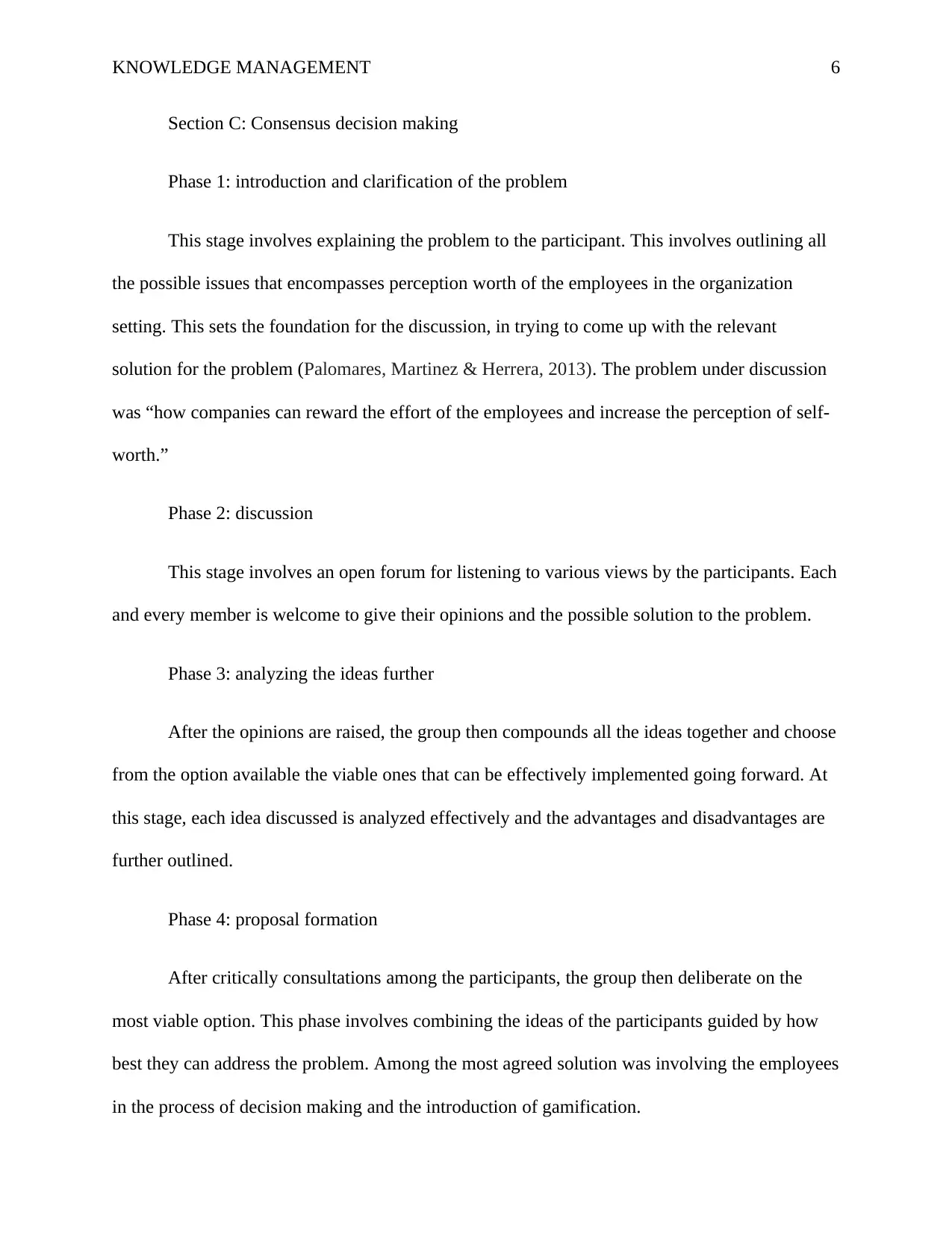
KNOWLEDGE MANAGEMENT 6
Section C: Consensus decision making
Phase 1: introduction and clarification of the problem
This stage involves explaining the problem to the participant. This involves outlining all
the possible issues that encompasses perception worth of the employees in the organization
setting. This sets the foundation for the discussion, in trying to come up with the relevant
solution for the problem (Palomares, Martinez & Herrera, 2013). The problem under discussion
was “how companies can reward the effort of the employees and increase the perception of self-
worth.”
Phase 2: discussion
This stage involves an open forum for listening to various views by the participants. Each
and every member is welcome to give their opinions and the possible solution to the problem.
Phase 3: analyzing the ideas further
After the opinions are raised, the group then compounds all the ideas together and choose
from the option available the viable ones that can be effectively implemented going forward. At
this stage, each idea discussed is analyzed effectively and the advantages and disadvantages are
further outlined.
Phase 4: proposal formation
After critically consultations among the participants, the group then deliberate on the
most viable option. This phase involves combining the ideas of the participants guided by how
best they can address the problem. Among the most agreed solution was involving the employees
in the process of decision making and the introduction of gamification.
Section C: Consensus decision making
Phase 1: introduction and clarification of the problem
This stage involves explaining the problem to the participant. This involves outlining all
the possible issues that encompasses perception worth of the employees in the organization
setting. This sets the foundation for the discussion, in trying to come up with the relevant
solution for the problem (Palomares, Martinez & Herrera, 2013). The problem under discussion
was “how companies can reward the effort of the employees and increase the perception of self-
worth.”
Phase 2: discussion
This stage involves an open forum for listening to various views by the participants. Each
and every member is welcome to give their opinions and the possible solution to the problem.
Phase 3: analyzing the ideas further
After the opinions are raised, the group then compounds all the ideas together and choose
from the option available the viable ones that can be effectively implemented going forward. At
this stage, each idea discussed is analyzed effectively and the advantages and disadvantages are
further outlined.
Phase 4: proposal formation
After critically consultations among the participants, the group then deliberate on the
most viable option. This phase involves combining the ideas of the participants guided by how
best they can address the problem. Among the most agreed solution was involving the employees
in the process of decision making and the introduction of gamification.
⊘ This is a preview!⊘
Do you want full access?
Subscribe today to unlock all pages.

Trusted by 1+ million students worldwide
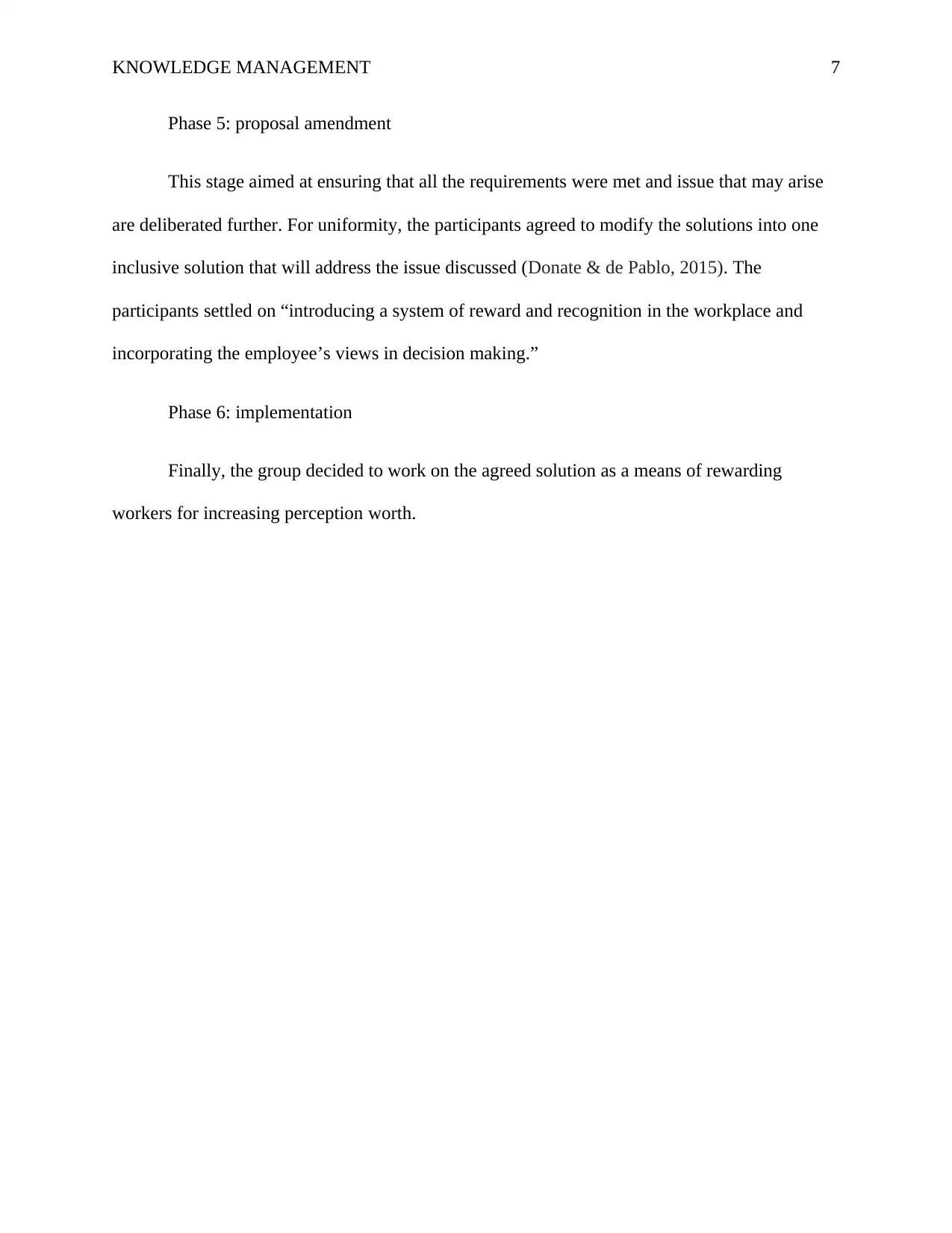
KNOWLEDGE MANAGEMENT 7
Phase 5: proposal amendment
This stage aimed at ensuring that all the requirements were met and issue that may arise
are deliberated further. For uniformity, the participants agreed to modify the solutions into one
inclusive solution that will address the issue discussed (Donate & de Pablo, 2015). The
participants settled on “introducing a system of reward and recognition in the workplace and
incorporating the employee’s views in decision making.”
Phase 6: implementation
Finally, the group decided to work on the agreed solution as a means of rewarding
workers for increasing perception worth.
Phase 5: proposal amendment
This stage aimed at ensuring that all the requirements were met and issue that may arise
are deliberated further. For uniformity, the participants agreed to modify the solutions into one
inclusive solution that will address the issue discussed (Donate & de Pablo, 2015). The
participants settled on “introducing a system of reward and recognition in the workplace and
incorporating the employee’s views in decision making.”
Phase 6: implementation
Finally, the group decided to work on the agreed solution as a means of rewarding
workers for increasing perception worth.
Paraphrase This Document
Need a fresh take? Get an instant paraphrase of this document with our AI Paraphraser
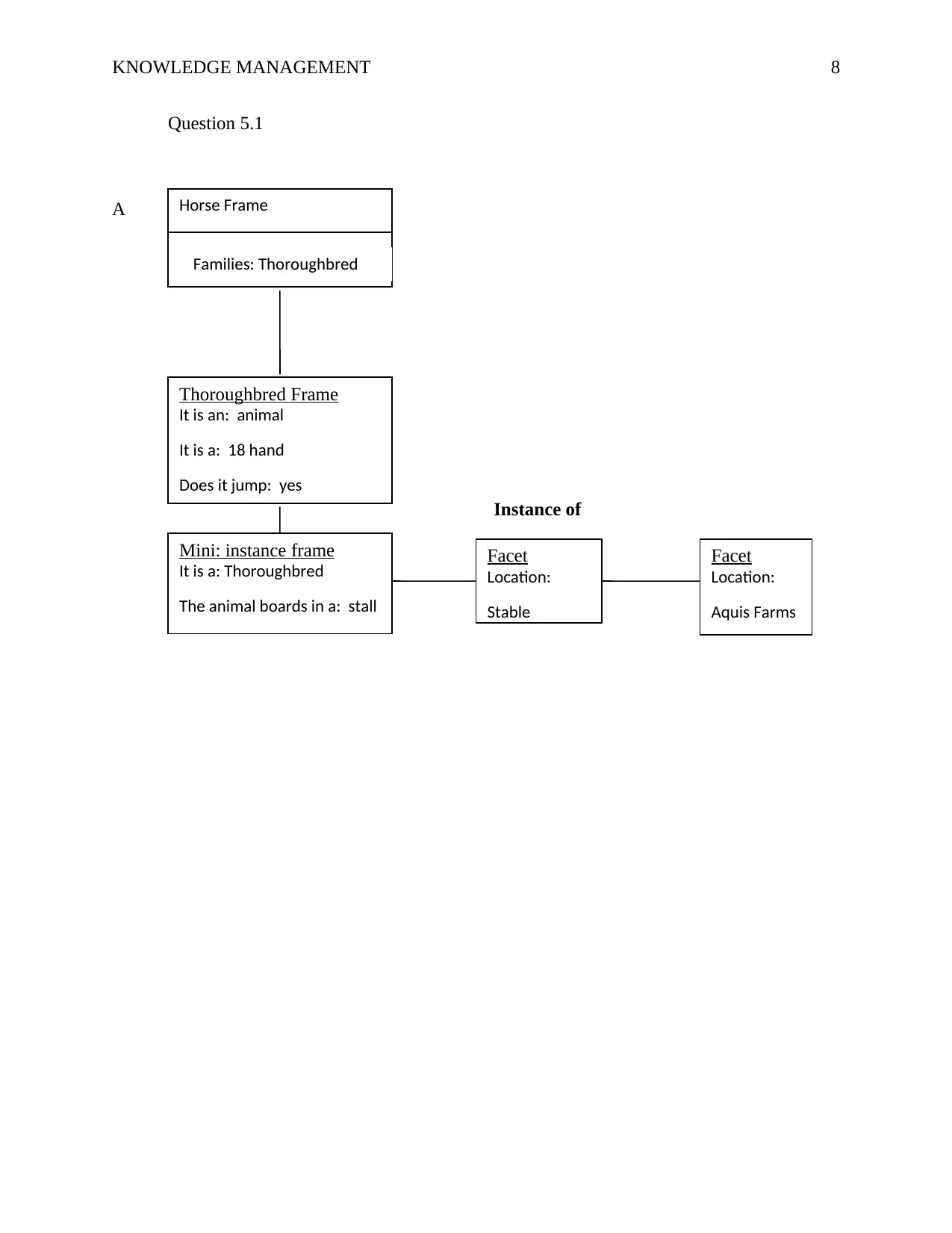
KNOWLEDGE MANAGEMENT 8
Question 5.1
A
Instance of
Horse Frame
Thoroughbred Frame
It is an: animal
It is a: 18 hand
Does it jump: yes
Families: Thoroughbred
Facet
Location:
Aquis Farms
Mini: instance frame
It is a: Thoroughbred
The animal boards in a: stall
Facet
Location:
Stable
Question 5.1
A
Instance of
Horse Frame
Thoroughbred Frame
It is an: animal
It is a: 18 hand
Does it jump: yes
Families: Thoroughbred
Facet
Location:
Aquis Farms
Mini: instance frame
It is a: Thoroughbred
The animal boards in a: stall
Facet
Location:
Stable
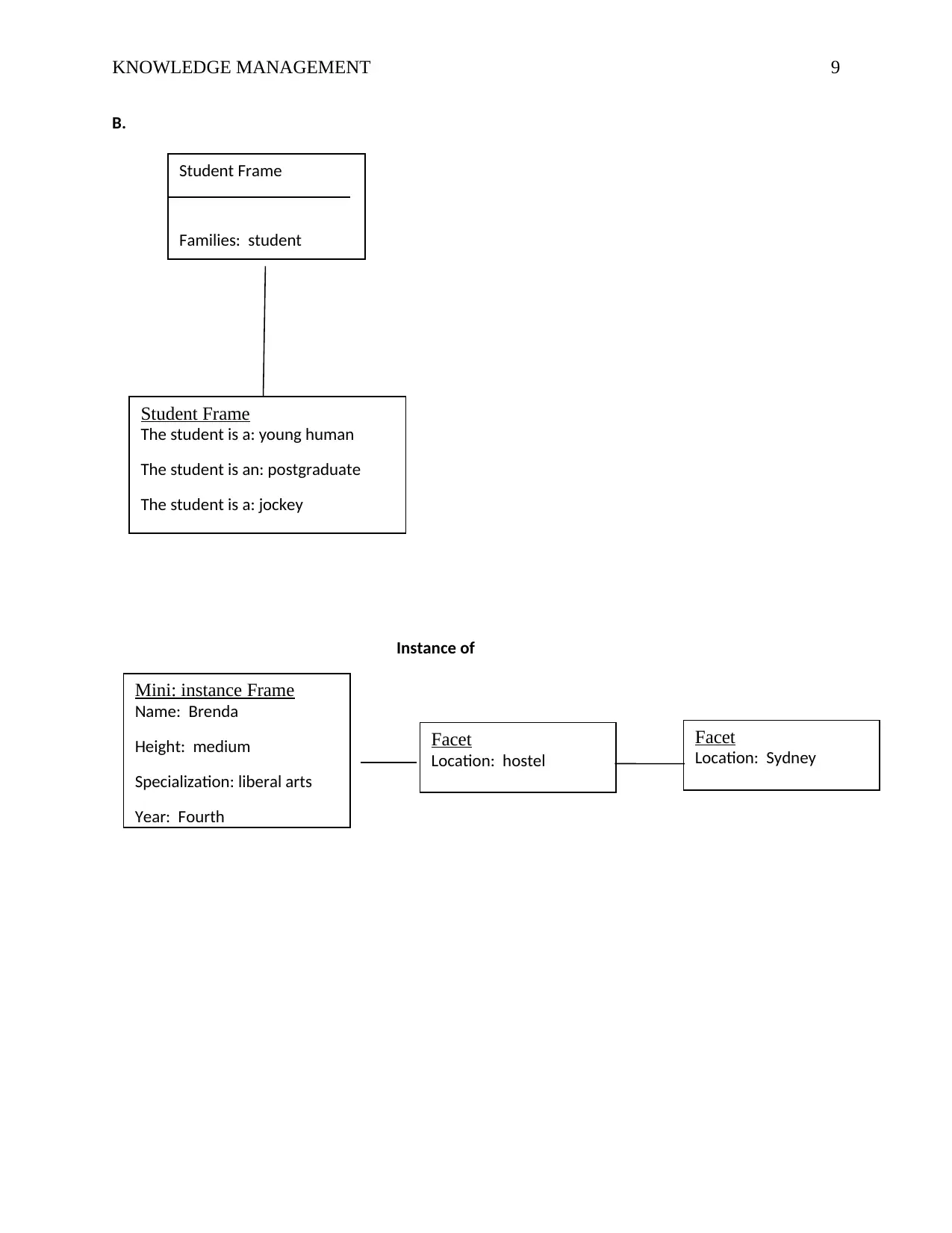
KNOWLEDGE MANAGEMENT 9
B.
Instance of
Student Frame
Families: student
Student Frame
The student is a: young human
The student is an: postgraduate
The student is a: jockey
Mini: instance Frame
Name: Brenda
Height: medium
Specialization: liberal arts
Year: Fourth
Facet
Location: hostel
Facet
Location: Sydney
B.
Instance of
Student Frame
Families: student
Student Frame
The student is a: young human
The student is an: postgraduate
The student is a: jockey
Mini: instance Frame
Name: Brenda
Height: medium
Specialization: liberal arts
Year: Fourth
Facet
Location: hostel
Facet
Location: Sydney
⊘ This is a preview!⊘
Do you want full access?
Subscribe today to unlock all pages.

Trusted by 1+ million students worldwide
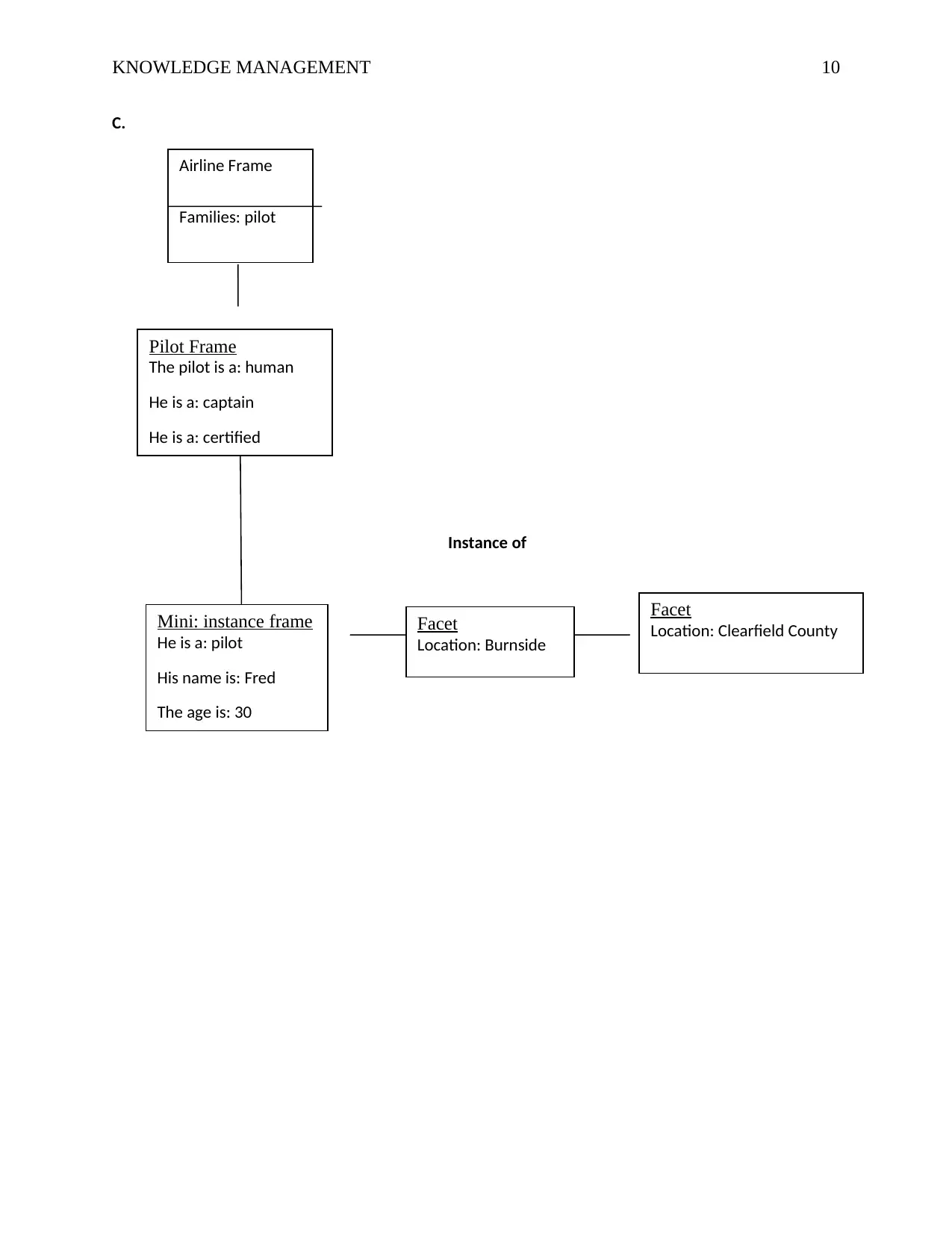
KNOWLEDGE MANAGEMENT 10
C.
Instance of
Airline Frame
Families: pilot
Pilot Frame
The pilot is a: human
He is a: captain
He is a: certified
Facet
Location: Burnside
Mini: instance frame
He is a: pilot
His name is: Fred
The age is: 30
Facet
Location: Clearfield County
C.
Instance of
Airline Frame
Families: pilot
Pilot Frame
The pilot is a: human
He is a: captain
He is a: certified
Facet
Location: Burnside
Mini: instance frame
He is a: pilot
His name is: Fred
The age is: 30
Facet
Location: Clearfield County
Paraphrase This Document
Need a fresh take? Get an instant paraphrase of this document with our AI Paraphraser
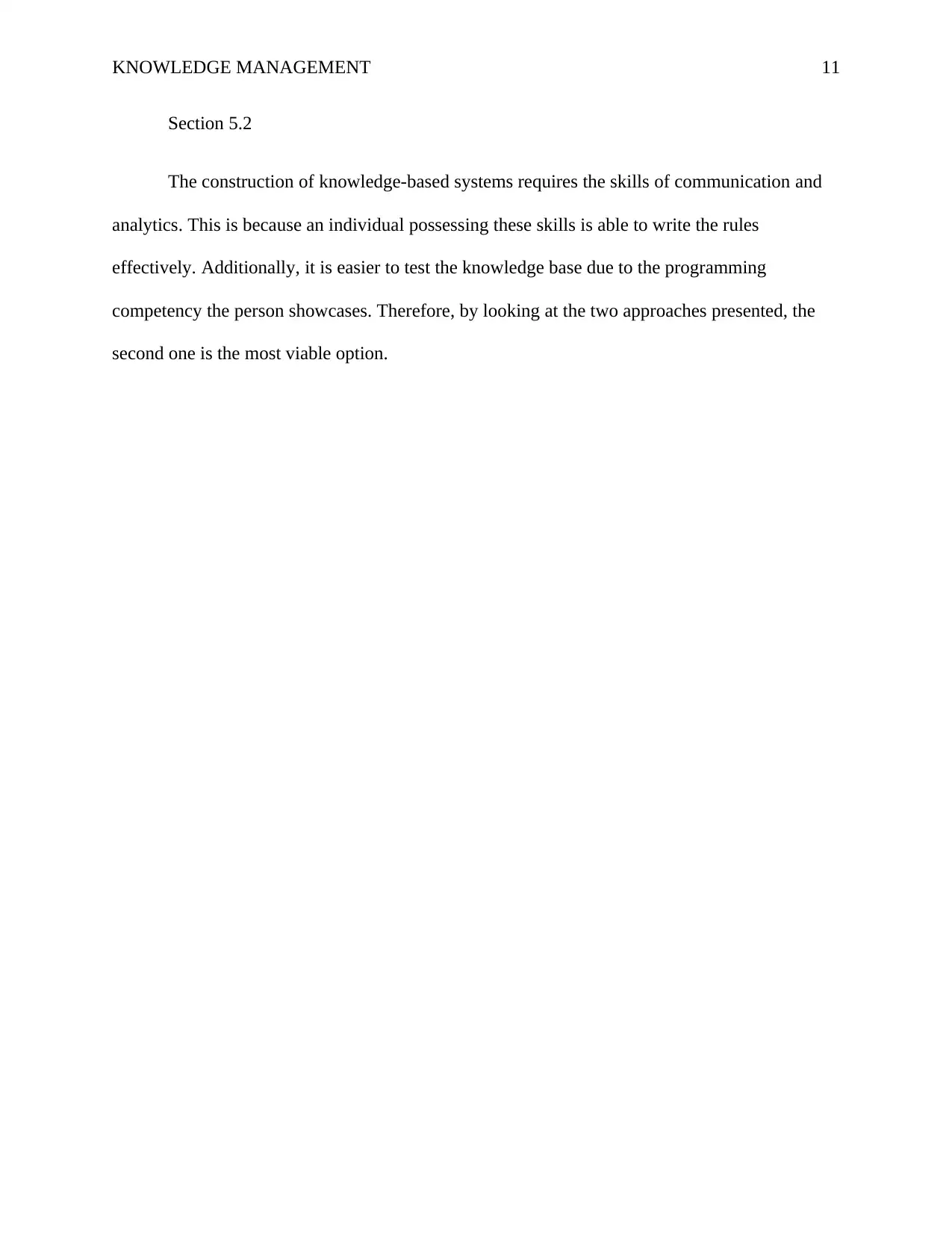
KNOWLEDGE MANAGEMENT 11
Section 5.2
The construction of knowledge-based systems requires the skills of communication and
analytics. This is because an individual possessing these skills is able to write the rules
effectively. Additionally, it is easier to test the knowledge base due to the programming
competency the person showcases. Therefore, by looking at the two approaches presented, the
second one is the most viable option.
Section 5.2
The construction of knowledge-based systems requires the skills of communication and
analytics. This is because an individual possessing these skills is able to write the rules
effectively. Additionally, it is easier to test the knowledge base due to the programming
competency the person showcases. Therefore, by looking at the two approaches presented, the
second one is the most viable option.
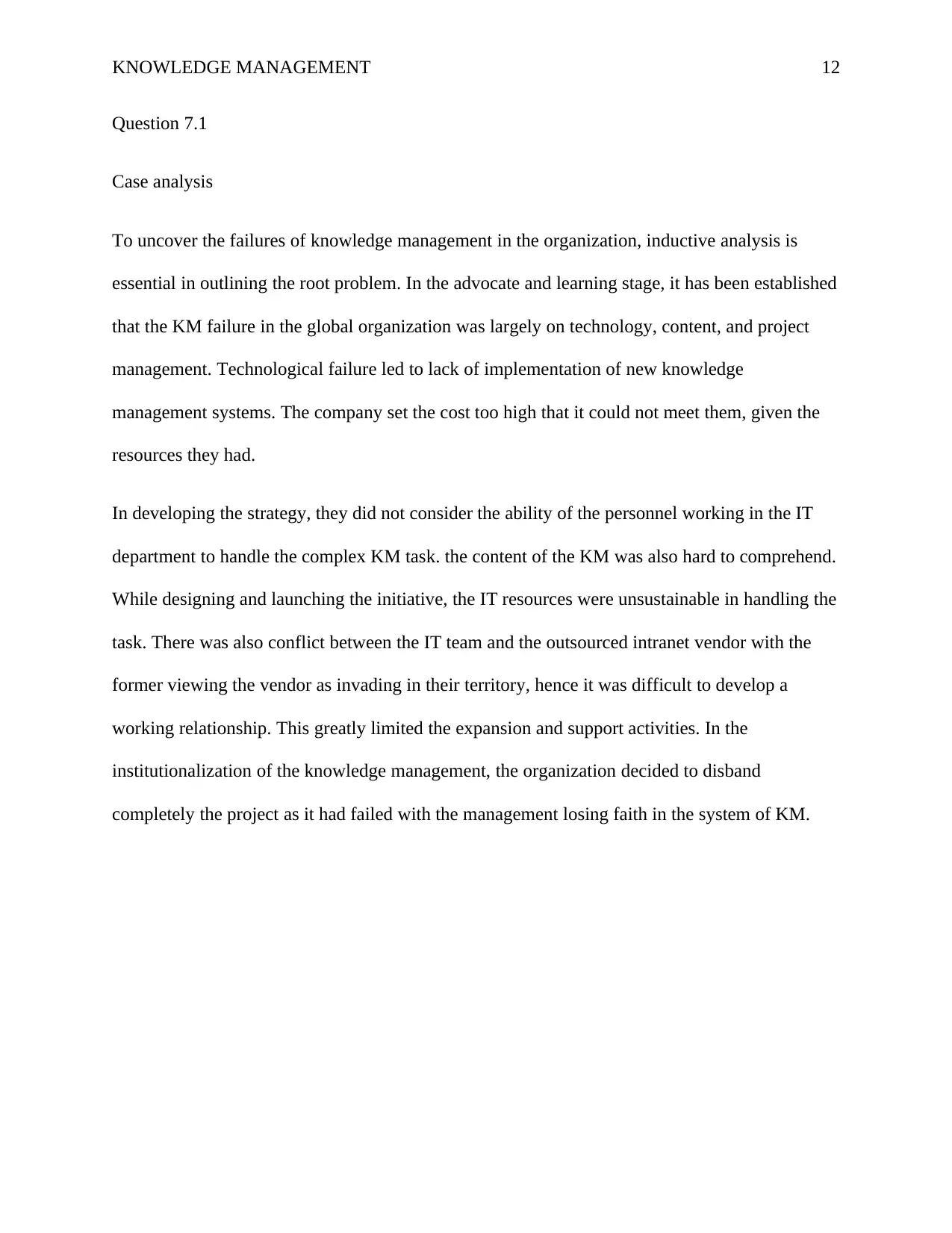
KNOWLEDGE MANAGEMENT 12
Question 7.1
Case analysis
To uncover the failures of knowledge management in the organization, inductive analysis is
essential in outlining the root problem. In the advocate and learning stage, it has been established
that the KM failure in the global organization was largely on technology, content, and project
management. Technological failure led to lack of implementation of new knowledge
management systems. The company set the cost too high that it could not meet them, given the
resources they had.
In developing the strategy, they did not consider the ability of the personnel working in the IT
department to handle the complex KM task. the content of the KM was also hard to comprehend.
While designing and launching the initiative, the IT resources were unsustainable in handling the
task. There was also conflict between the IT team and the outsourced intranet vendor with the
former viewing the vendor as invading in their territory, hence it was difficult to develop a
working relationship. This greatly limited the expansion and support activities. In the
institutionalization of the knowledge management, the organization decided to disband
completely the project as it had failed with the management losing faith in the system of KM.
Question 7.1
Case analysis
To uncover the failures of knowledge management in the organization, inductive analysis is
essential in outlining the root problem. In the advocate and learning stage, it has been established
that the KM failure in the global organization was largely on technology, content, and project
management. Technological failure led to lack of implementation of new knowledge
management systems. The company set the cost too high that it could not meet them, given the
resources they had.
In developing the strategy, they did not consider the ability of the personnel working in the IT
department to handle the complex KM task. the content of the KM was also hard to comprehend.
While designing and launching the initiative, the IT resources were unsustainable in handling the
task. There was also conflict between the IT team and the outsourced intranet vendor with the
former viewing the vendor as invading in their territory, hence it was difficult to develop a
working relationship. This greatly limited the expansion and support activities. In the
institutionalization of the knowledge management, the organization decided to disband
completely the project as it had failed with the management losing faith in the system of KM.
⊘ This is a preview!⊘
Do you want full access?
Subscribe today to unlock all pages.

Trusted by 1+ million students worldwide
1 out of 14
Related Documents
Your All-in-One AI-Powered Toolkit for Academic Success.
+13062052269
info@desklib.com
Available 24*7 on WhatsApp / Email
![[object Object]](/_next/static/media/star-bottom.7253800d.svg)
Unlock your academic potential
Copyright © 2020–2025 A2Z Services. All Rights Reserved. Developed and managed by ZUCOL.





